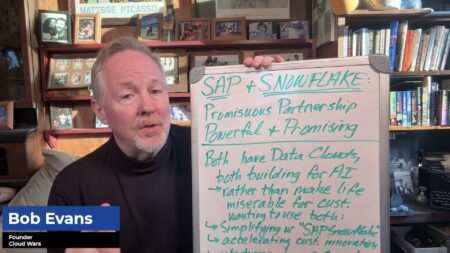
If you’re wondering why Microsoft CEO Satya Nadella launched an all-out market-share blitz in the cloud last week, the reason is clear: For Q2, AWS and Google Cloud once again grew much faster than Microsoft in the cloud and are grinding away at its formerly overwhelming lead.
Just to be clear: I’m not talking about just the subsegment of cloud infrastructure that is so often the focus of various reports in the media and from some analysts. My coverage at Cloud Wars has always been on the entire cloud portfolios of the major providers, encompassing not only infrastructure but also applications, databases, and other software services.
Here are the Q2 growth rates and revenue totals for those three companies:
- Microsoft up 28% to $25 billion;
- AWS up 33% to $19.7 billion; and
- Google Cloud up 36% to $6.3 billion.
Clearly, Microsoft is by far the biggest cloud vendor. As those staggering quarterly revenue figures get increasingly larger, it’s more and more difficult for Microsoft to maintain growth rates of 30% or more.
But beyond these Q2 figures in isolation, what we have here is an ongoing trend: AWS has grown more rapidly than Microsoft’s cloud business for 5 straight quarters in a row. Yes, the market is enormous and will, I believe, continue to get bigger over the next few years — but as that is happening, AWS is expanding at a faster rate than the Microsoft Cloud business.
This is something I’ve pointed out before because what we’re talking about here is, after all, “the greatest growth market the world has ever known.” In that context, among all the ravenous growth monsters out there, it is illuminating to know who’s gobbling up opportunities more rapidly than its competitors are.
And if you look at the numbers for the past 5 quarters, the very unambiguous answer is that AWS is chewing into Microsoft’s previously unassailable lead in the cloud by the simple virtue of growing more rapidly. Here are the cloud-revenue growth rates for the past 5 quarters — and for clarity, I’m listing them by calendar quarters, even though Microsoft’s fiscal year starts July 1 and ends June 30.
- Q2 2022: Microsoft Cloud + 28%, AWS + 33%
- Q1 2022: Microsoft Cloud + 32%, AWS + 37%
- Q4 2021: Microsoft Cloud + 32%, AWS + 40%
- Q3 2021: Microsoft Cloud + 36%, AWS + 39%
- Q2 2021: Microsoft Cloud + 36%, AWS + 37%
While only one-quarter the size of Microsoft Cloud, Google Cloud continues to grow much more rapidly as it, like Microsoft, addresses not only cloud infrastructure but also applications and related industry-specific solutions that businesses need so desperately today to keep pace with rapidly changing customer requirements.
In this context, we can understand more clearly the rationale for Nadella’s declaration at the top of Microsoft’s July 26 earnings call that “we will invest to take share and build new businesses and categories.” It’s a clear indication that Nadella is committed to reversing the trend revealed in the quarterly comparative numbers above.
As I described in a piece last week called Microsoft Launches Market-Share War, and Customers Will Surely Win, both Nadell and CFO Amy Hood hammered home that theme of “taking share” throughout the entire earnings call as they specifically cited that ambition more than a dozen times. From that article, here’s how they made that point repeatedly and aggressively:
CEO Nadella
- “We will invest to take share and build new businesses and categories where we have long-term structural advantage.”
- “Teams is taking share across every category from collaboration to chat to meetings to calling and seeing higher usage intensity….”
- “Despite a changing market for PCs during the quarter, we continue to see more PCs shipped than pre-pandemic and are taking share.”
- In cybersecurity, “We’re taking share across all major categories we serve.”
- “We are focused on increasing our share and engagement across Edge, Bing, and our personalized content feed, Microsoft Start.”
- “And Edge continues to gain share as consumers use it to save money with our built-in coupon and price comparison features.”
CFO Hood
- “In our consumer business, despite those macro challenges, we drove another quarter of share gains for Windows in the PC market and for Edge in browsers.”
- “And as you heard from Satya, we saw share gains in areas such as data and AI, Dynamics, Teams, and security.”
- “We continue to expect double-digit revenue and operating income growth in both constant currency and U.S. dollars. Revenue growth will be driven by continued momentum in our commercial business and a focus on share gains across our portfolio.”
- “Our differentiated market position, customer demand across our solution portfolio, and consistent execution across the Microsoft Cloud should drive another strong quarter of revenue and share growth, although we expect to continue to see growth moderation in our small- and medium-sized business segment.”
- “And in Dynamics, we expect revenue growth in the mid-to-high teens, driven by share growth in Dynamics 365.”
- “In closing, we continue to see strong demand for our products and services and increased commitment to our platform as we remain focused on delivering compelling customer value in this dynamic environment, resulting in continued share gains.”
- Responding to a question about Azure growth: “I feel good about the workloads that Satya mentioned and where we feel like we can take some share.”
Now, you might look at this and so, “Big deal — who cares?” And you might be right.
But I’ve followed these companies pretty closely for many years and I do not recall Nadella ever using this type of pointed messaging about “taking share.” When you add on the parallel reality that it has been AWS and Google Cloud doing the share-taking over the past several quarters, then it becomes clear that the world’s largest and most influential cloud vendor — that would be Microsoft— is about to do its utmost to change the way the game is played.
And that means the Cloud Wars are about to heat up even more.
Want to gain more insights from Bob Evans and view cloud-focused content from Cloud Wars Expo? On-demand video from the event is rolling out now, with more than 40 hours of cloud education content — featuring 100-plus speakers — to be made available in the coming days. All content is free to Acceleration Economy subscribers with an on-demand pass.








